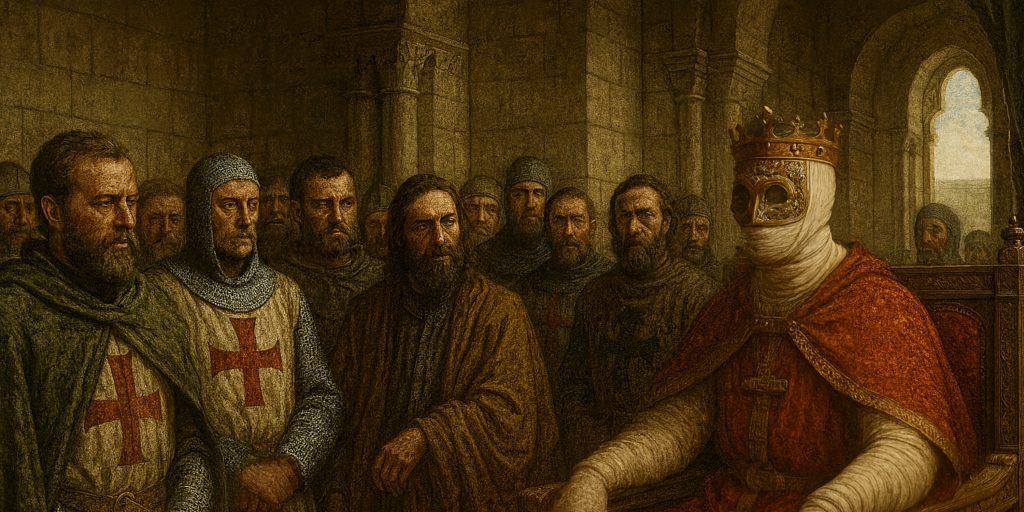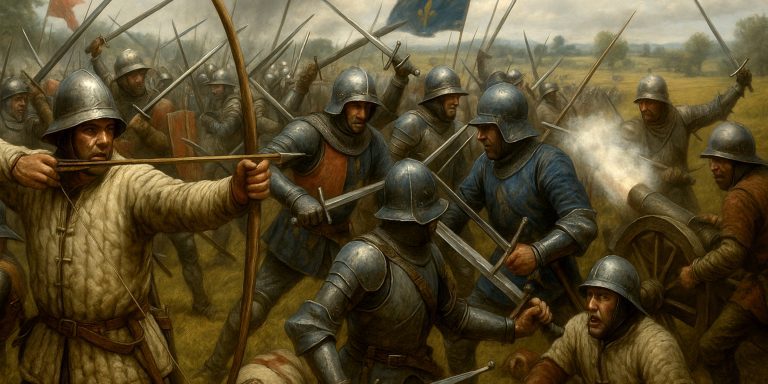
Raynald of Châtillon (c. 1124–1187) was a prominent and controversial figure of the Crusader era. His life was shaped by military ambition, political opportunism, and a defiant posture toward both Muslim and Christian authorities. He served as Prince of Antioch from 1153 to 1160 and later ruled the Lordship of Oultrejordain, overseeing key strongholds such as Kerak and Montréal.
Initially rising to prominence through marriage to Constance of Antioch, Raynald quickly gained notoriety for his aggressive conduct. His rule in Antioch was marked by brutality, including the torture of Patriarch Aimery of Limoges to secure funds, and a notorious raid on Cyprus that infuriated the Byzantine Empire. His forced submission to Emperor Manuel I Komnenos did little to redeem his reputation.
Captured during a campaign on the Euphrates in the early 1160s, he spent over a decade imprisoned in Aleppo. Upon his release, Raynald married Stephanie of Milly, gaining control of strategic fortresses east of the Jordan River. These holdings gave him considerable influence, particularly over trade and pilgrimage routes.
Raynald’s career was defined by confrontation. He defied royal truce agreements and repeatedly raided Muslim caravans, including an infamous attack on a pilgrimage caravan despite a standing peace with Saladin. This provocation contributed directly to the chain of events leading to the Battle of Hattin, where the Crusader army suffered a devastating defeat. Captured after the battle, Raynald was executed by Saladin for his repeated violations of truces and refusal to convert to Islam.
Arms and Armour
There are no surviving personal artefacts attributed to Raynald of Châtillon, but his military status implies the use of standard high-status Crusader equipment of the 12th century. This would likely have included:
- A hauberk (chain mail shirt) with coif
- A Norman-style helmet with nasal guard
- A kite shield, common among Latin knights
- A single-handed arming sword
- Possibly a horseman’s mace or axe
These items were typical of Frankish lords in the Levant and appear in manuscript illustrations from the period.
Reynald of Châtillon and Baldwin IV

Reynald’s relationship with King Baldwin IV of Jerusalem was complex but ultimately instrumental in elevating his power in the region. Upon Reynald’s release from captivity in 1176, he quickly married Stephanie of Milly, one of the wealthiest and most influential noblewomen in the kingdom. This marriage placed him in control of the Lordship of Oultrejordain, including the key fortresses of Kerak and Montréal. However, this acquisition was not achieved through marriage alone—it required Baldwin IV’s direct approval.
The king, afflicted by leprosy and facing persistent political instability, relied on powerful lords to hold the frontier against Saladin. Granting Hebron and confirming Reynald’s control of Oultrejordain was likely a calculated decision to secure a militarised buffer zone along the eastern border. Baldwin IV seems to have viewed Reynald’s aggressive posture as useful, if difficult to manage. Though Reynald lacked the trust and status of long-standing nobles like Raymond III of Tripoli, Baldwin allowed him a prominent military role, including command during the critical Battle of Montgisard in 1177, where Christian forces defeated a far larger Muslim army under Saladin.
Yet their relationship was not without tension. Reynald’s frequent breaches of truces and raids on Muslim caravans, often without royal sanction, placed Baldwin in a difficult position diplomatically. These actions risked provoking Saladin and undermining fragile peace agreements, forcing Baldwin to navigate a path between asserting royal authority and maintaining unity among a fractious nobility.
Despite these strains, Baldwin never stripped Reynald of his lands or rank. Instead, he tolerated the lord of Oultrejordain’s independence, possibly out of necessity, as few other barons had the means or the will to hold such a volatile frontier. Their relationship, while not warm, was bound by shared interests: defence of the kingdom and resistance to Saladin’s growing power.
In the final years of Baldwin’s reign, as the king’s health deteriorated and internal rivalries sharpened, Reynald’s influence grew. He aligned closely with Baldwin’s sister Sibylla and her husband Guy of Lusignan, and supported their eventual claim to the throne. This placed him in direct opposition to the faction led by Raymond of Tripoli, deepening the divisions that would hasten the kingdom’s fall after Baldwin’s death.
In sum, Baldwin IV regarded Reynald as a blunt but necessary instrument, unpredictable, aggressive, and dangerous, but capable of holding territory and leading in battle. Their relationship was defined more by shared pragmatism than trust, and it reflected the desperate, shifting alliances that marked the twilight years of the Crusader Kingdom.
Battles and Military Acumen
Raynald’s military reputation is polarising. On one hand, he was instrumental in securing a Christian victory at the Battle of Montgisard in 1177. On the other, his conduct was often marked by recklessness and disregard for diplomacy.
Notable engagements and activities include:
- Battle of Montgisard (1177): Raynald played a key role in leading the Crusader forces to a surprising victory against Saladin’s much larger army.
- Red Sea raids (c. 1182–83): He launched ships across the desert to attack Muslim coastal settlements and threaten pilgrimage routes, a move that was both daring and incendiary.
- Raids on caravans: These continuous breaches of truces undermined the Kingdom of Jerusalem’s diplomatic standing and enraged Saladin.
- Battle of Hattin (1187): His actions contributed to Saladin’s invasion. After the Crusader defeat, he was executed personally by Saladin.
Historians remain divided on whether Raynald’s provocations were strategically sound or merely self-serving. Some argue he sought to destabilise Muslim unity; others view his actions as reckless, prioritising short-term gain over collective security.
Where to See Artefacts
While no items directly linked to Raynald survive, several sites and collections provide insights into his world:
- Kerak Castle (Jordan): Once Raynald’s stronghold, this imposing Crusader fortress still stands. Its strategic design and commanding position offer a glimpse into his power base and the military architecture of the time.
- Montreal Castle (Jordan): Another of Raynald’s holdings, it guarded the overland routes between Egypt and Syria.
- Crusader-era weaponry and armour: Museums in Jerusalem, London, Paris, and Istanbul display period-appropriate swords, mail, and shields used by knights of the same class and era.
Latest Archaeology
Recent scholarship has shed light on the broader role of Crusader lordships like Oultrejordain. Rather than being remote outposts, these regions served as economic and military hubs. Archaeological studies of Kerak and Montreal have uncovered:
- Domestic structures and defensive reinforcements added under Raynald’s command
- Pottery and trade goods indicating sustained activity and exchange
- Naval infrastructure connected to his Red Sea expeditions
Research by archaeologists like Micaela Sinibaldi and Michael Fulton has helped reframe the perception of Raynald’s holdings. Far from isolated castles, they were part of a broader network of fortified governance, commercial taxation, and aggressive regional control.
The Seven Swords Takeaway
Raynald of Châtillon was not merely a belligerent baron or Crusader iconoclast. He was a man of real power, ambition, and consequence. His brutal tactics, disregard for political restraint, and unyielding hostility towards Muslim powers played a critical role in shaping the fate of the Crusader states. Whether seen as a dangerous liability or a necessary counterforce to Saladin’s expansion, Raynald remains one of the most debated figures of the Crusader period. His legacy endures in stone and story, from the ruins of Kerak to the chronicles of both his enemies and peers.
Watch the documentary:



